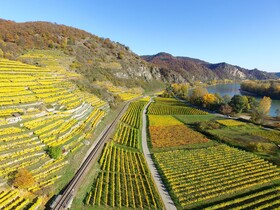


For the CAP funding period 2021-2027, all EU Member States must for the first time develop a National Strategic Plan for the promotion of the 1st and 2nd pillar of the CAP. This plan is intended to enable the member states to use support measures in a targeted manner and to align them with national needs. The Federal Ministry of Food and Agriculture (BMEL) is responsible for drawing up the plan in Germany. A strengths, weaknesses, opportunities and threats analysis was used to determine the use of EU financial resources in Germany after a transitional phase of two years starting in 2023. The aim of the reform: to create structured framework conditions that will maintain the competitiveness of agriculture and at the same time meet changing social and ecological demands. The support measures available to farmers and rural areas are to be modernised and made more efficient. In addition, the administrative burden for support measures is to be reduced.
Around 6.3 billion euros in EU funding will be available annually for agricultural support in Germany in the coming years. The first pillar, with direct payments, accounts for the bulk of this, with annual funding of €4.9 billion.
Since 2015, there have been four building blocks for direct payments under the first pillar in Germany:
In 2023, 10 percent and, rising to 2026, 15 percent of the annual direct payments are to be transferred to the second pillar of the CAP. In addition, 25 percent of direct payments will be linked to higher environmental and climate protection performance: To receive money from this 25 percent, farmers must implement a catalogue of organic schemes that go beyond the general environmental and climate protection measures. Farmers can carry out these implementations specifically for their farm. Thanks to the reform, there is also a higher redistribution premium in favour of small and medium-sized farms: 12 percent of direct payments are now earmarked for this purpose. Young farmers will also receive targeted support, for which about 98 million euros per year are available. In addition, market measures are financed from the first pillar. These include measures to stabilise the market in the event of falling prices, support measures for viticulture, the production of fruit and vegetables, hop cultivation and beekeeping. In the current funding period, about 150 million euros are available annually for this purpose in Germany.
The previous cross-compliance requirements for receiving direct payments as well as for greening will be merged in the so-called conditionality. Thus, in future, every subsidised hectare will be tied to higher environmental, climate and animal protection measures. In addition, at least three percent of arable land must be set aside by farmers as non-productive land or landscape elements. In addition, direct payments are to be reallocated annually to the second pillar: in 2022 there is the possibility of reallocating eight percent. Direct payments have already been reallocated to the second pillar annually since 2015. From 2015 to 2019, this amounted to 4.5 percent annually, and 6 percent in 2020 and 2021 respectively.
For the second pillar, Germany will receive around 1.1 billion euros annually in the funding period 2021-2027. The funds that will be transferred from the first to the second pillar amount to approximately 300 million euros in 2021. In Germany, the second pillar also includes programmes to promote climate and environmental protection measures, to improve competitiveness and to promote rural areas. In both 2021 and 2022, the second pillar also has funds from the EU's reconstruction fund. These are to be used to mitigate the consequences of the Corona pandemic.
Year | 2021 | 2022 | 2023 | 2024 | 2025 | 2026 | 2027 |
Direct payments | 4.916 | 4.916 | 4.916 | 4.916 | 4.916 | 4.916 | 4.916 |
Market measures | 150 | 150 | 150 | 150 | 150 | 150 | 150 |
1st pillar total | 5.066 | 5.066 | 5.066 | 5.066 | 5.066 | 5.066 | 5.066 |
ELER | 1.334 | 1.092 | 1.092 | 1.092 | 1.092 | 1.092 | 1.092 |
ELER-Reconstruction Fund | 210 | 500 |
|
|
|
|
|
2nd pillar total | 1.544 | 1.592 | 1.092 | 1.092 | 1.092 | 1.092 | 1.092 |
CAP total | 6.610 | 6.658 | 6.158 | 6.158 | 6.158 | 6.158 | 6.158 |
The shape of the CAP for the coming funding period can be found here.